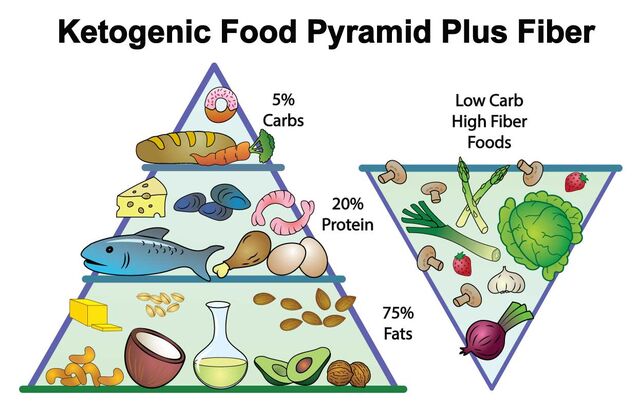Diet
What’s Wrong with the Keto Diet, and How to Fix It
The ketogenic diet is popular, but what is it doing to your gut microbes?
Posted April 27, 2022 Reviewed by Gary Drevitch
Key points
- The keto diet limits carbs, which can lead to a reduction in fiber intake.
- Without a diverse diet of prebiotic fiber, the microbiota can become dysbiotic.
- An unbalanced gut can become leaky, leading to inflammation.
- The brain can be affected by inflammation, producing brain fog and depression.
What is the keto diet? Simply stated, the keto diet emphasizes fats in favor of carbs for energy. For such a trendy diet, it has surprisingly old roots, and it all started with epilepsy.

Hippocrates knew he could cure epilepsy with fasting. But it was ultimately discovered that you don’t need to stop eating everything to alleviate seizures; just cutting out carbs is sufficient. You can eat as much fat as you can handle without increasing epileptic seizures.
By the 1920s a high-fat, low-carb diet was regularly used to treat epilepsy in children. Although anti-convulsant drugs are now the most common way to treat seizures, the keto diet is still used by people who are resistant to the drugs or who simply prefer a more natural solution. At least half of epileptic patients are helped by a keto diet, sometimes dramatically. So, as weird as it sounds, convulsions in the brain are affected by carbs in your diet—another astonishing example of the gut-brain axis in action.
Not just for epilepsy
Today, the keto diet is more popular for helping with metabolic syndrome, a collection of nasty conditions including high blood pressure, high blood sugar, and high cholesterol. Metabolic syndrome puts you on the road to type 2 diabetes and obesity, or so-called diabesity. It also carries an increased risk of depression and anxiety.
High blood sugar is often attributed to insulin resistance: an inability to process glucose properly. Sugars build up in the blood and can become toxic to every organ in the body. Insulin’s job is to chaperone sugars into your cells for energy, but if dietary sugar swamps the system, insulin reroutes it to fat cells, paradoxically leaving the rest of your cells starving. That leads to both fat buildup and hunger, a one-two punch for weight gain and diabetes. Eliminating sugars and starch can be a life-saver.
But without carbs, where does your body get its energy? Like a hybrid car, your body can run on multiple fuels – including fat. When it does, the liver produces fatty acids called ketones that can power metabolism as well as sugar does. The brain, which normally consumes a lot of glucose, can run just fine on ketones. In fact, this alternative fuel is likely why epileptic seizures stop.
You may lose weight when your body switches over to burning fat. Lowering carbs reduces sugar in the blood, which lessens the need for insulin. That can reduce fat storage and can reduce both weight gain and diabetes.
A strict keto diet promotes a 4:1 ratio of fats to carbs/proteins, but that’s not always easy to do. Diets to reduce seizures try to keep your carbs below 15 grams per day. That’s about three pretzels or a tablespoon of maple syrup. On the other hand, with no limit for fats, you could consume about 40 pounds of butter a day (but don’t).
However, if you are working to address metabolic syndrome and not epilepsy, most keto diets only require staying below 50 to 100 grams of carbs a day. Variations on the keto diet include Atkins and Paleo, both of which attempt to lower carbs and especially processed sugar. A typical keto diet contains about 75% fats, 20% proteins, and 5% carbs.
Problems with the diet
Here is a potential problem: Diabetics, when their insulin levels drop precipitously, can enter a state of ketoacidosis in which ketones build up to dangerous levels in the body. Diabetic ketoacidosis is a leading cause of death in people under 30 with diabetes, so this is not a small matter. However, it is of greatest concern for people with type 1 diabetes, and the levels of ketones in diabetic ketoacidosis are 5 to 10 times higher than the levels in dietary ketosis.
Still, diabetics might want to use caution with a keto diet. If you are diabetic, talk to your doctor before going keto. Having said that, a keto diet may help people with type 2 diabetes to improve their blood sugar levels.
Some other risks of the keto diet include:
- Kidney stones
- Brain fog
- Constipation
- Micronutrient deficiencies
- Loss of microbial diversity
How to fix the keto diet
Looking at the list above, there are some simple fixes. For kidney stones, make sure to drink lots of water. For the other four items on the list, a single dietary addition may help: prebiotic fiber. Studies show that a healthy gut microbiota is a diverse one. But if you are avoiding carbs, it may be hard to get the diverse prebiotic fiber that microbes love. Those starving microbes include psychobiotics – microbes that improve your mood. Their lack may contribute to the brain fog and depression that many people report on a keto diet.
The problem is that foods containing fiber, like chicory root and Jerusalem artichokes, often contain carbs as well. This can be confusing, because fiber is listed as a carb on food labels even though your body can’t digest it. Only your gut microbes can process fiber, converting it into nourishing and healing short-chain fatty acids. To calculate how many net carbs a food actually has, subtract the fiber from the carbs.
Many foods with carbs also contain micronutrients, flavonoids, and polyphenols, so if you are going to eliminate carb-loaded foods from your diet, you might want to top off with a prebiotic or polyphenol supplement. Make sure the supplement doesn’t contain added sugars.
A healthy microbiota can also help you deal with high cholesterol levels that some people get from eating so much fat. Probiotics and prebiotics can help here too, because certain species of bacteria can lower bad cholesterol.
In sum, research indicates that carbs can be a problem for the Western world with rampant diabesity, but you still need to take care of your microbiota. Eat plenty of green veggies and look for a prebiotic blend designed to supplement your fiber needs without raising your carb load.
The keto diet may help you combat metabolic syndrome, but don’t leave your microbes in the lurch.
References
Gershuni, Victoria M., Stephanie L. Yan, and Valentina Medici. “Nutritional Ketosis for Weight Management and Reversal of Metabolic Syndrome.” Current Nutrition Reports 7, no. 3 (September 1, 2018): 97–106.
Agerholm-Larsen, L., M. L. Bell, G. K. Grunwald, and A. Astrup. “The Effect of a Probiotic Milk Product on Plasma Cholesterol: A Meta-Analysis of Short-Term Intervention Studies.” European Journal of Clinical Nutrition 54, no. 11 (November 2000): 856–60.
Bear, Tracey L K, Julie E Dalziel, Jane Coad, Nicole C Roy, Christine A Butts, and Pramod K Gopal. “The Role of the Gut Microbiota in Dietary Interventions for Depression and Anxiety.” Advances in Nutrition 11, no. 4 (July 2020): 890–907.




